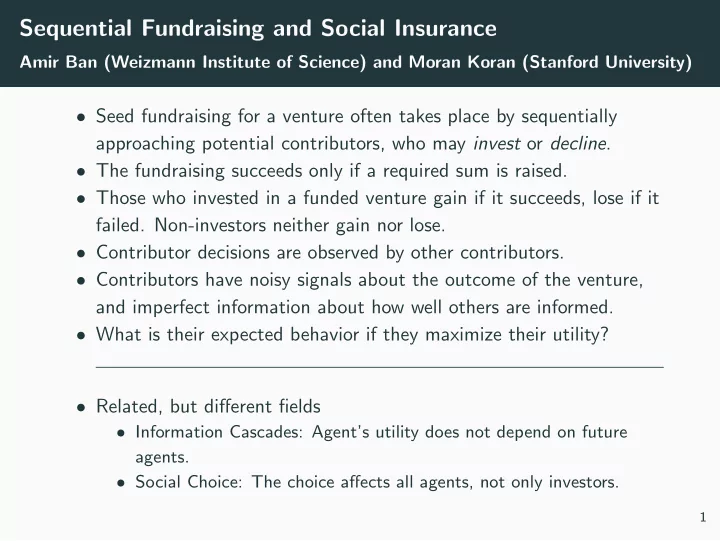

Sequential Fundraising and Social Insurance Amir Ban (Weizmann Institute of Science) and Moran Koran (Stanford University) • Seed fundraising for a venture often takes place by sequentially approaching potential contributors, who may invest or decline . • The fundraising succeeds only if a required sum is raised. • Those who invested in a funded venture gain if it succeeds, lose if it failed. Non-investors neither gain nor lose. • Contributor decisions are observed by other contributors. • Contributors have noisy signals about the outcome of the venture, and imperfect information about how well others are informed. • What is their expected behavior if they maximize their utility? • Related, but different fields • Information Cascades: Agent’s utility does not depend on future agents. • Social Choice: The choice affects all agents, not only investors. 1
Model • An entreprenuer approaches a set of n potential investors. • Investors are approached by a predetermined order. Each publicly decides whether to invest. • Rewards apply only to investors, and are realized only if B ≤ n investors commited to invest. • The project can be “good” ( ω = 1) or “bad” ( ω = 0). Agent utility from investing in a “good” project is 1 and from investing in a “bad” project is − 1 . • Agents have a common public likelihood L = Pr( ω =1) Pr( ω =0) . • Each agent receives a private signal s i ∈ { 0 , 1 } independent conditionally on ω . The quality of each agent signal is private q i = Pr( s i = ω ) , and is i.i.d. drawn from a commonly known distribution q ∈ ∆([ R , Q ]) where 1 2 ≤ R < Q < 1. • We study Markov-Perfect equilibria in this game. • The payoff-relevent state is described by the triplet ( L , B , n ). 2
Main Results In the general problem B ≤ n , with public likelihood L • Threshold Strategy : All strategies are unique, pure, threshold strategies. Q • Up-Cascade : The fundraising is in an up-cascade when L ≥ 1 − Q . (Therefore) learning stops above Pr[ ω = 1] = Q . • Down-Cascade : The fundraising is in a down-cascade when � B � 1 − Q L ≤ . Q • Social Insurance : Players shade their threshold for investment lower (relative to when in last position). • In other words, players enter in positions that would be losing if not “protected” by future players’ behavior. • Delegation : A player may herd on investment, i.e., “waste” her information and delegate the decision to others, even though not in a cascade . • Reverse Cascades : Often, a fundraising starts with all early contributors delegating (investing unconditionally). 3
B = n = 2 Threshold Strategies in Equilibrium Two players (called “Dad” and “Mom”), needing a unanimous decision, with uniformly-distributed qualities U ( R , 0 . 8), for R = 0 . 5 , 0 . 65 , 0 . 8. n = B = 2 , q ∼ U (0 . 5 , 0 . 8) n = B = 2 , q ∼ U (0 . 65 , 0 . 8) n = B = 2 , q ∼ U (0 . 75 , 0 . 8) Observations: • The players often, but not always, play the same threshold. • No delegation (threshold ≤ 1 − Q ) takes place for R ≤ 0 . 620 ... , or at low L (public likelihood). 4
Recommend
More recommend